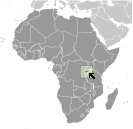World Atlas: Rwanda. On this page you can see the map, country flag and many detailed information about the people, history and economy of Rwanda.

Here you can find online selected information about the geography, inhabitants, government, economy and history of Rwanda. Included are selected statistics, an overview map and the detailed map of Rwanda. But let's start with the flag of Rwanda here:
Rwanda - Overview:
What you should know about Rwanda? Let's start with this: In 1959, three years before independence from Belgium, the majority ethnic group, the Hutus, overthrew the ruling Tutsi king. Over the next several years, thousands of Tutsis were killed, and some 150,000 driven into exile in neighboring countries. The children of these exiles later formed a rebel group, the Rwandan Patriotic Front (RPF), and began a civil war in 1990. The war, along with several political and economic upheavals, exacerbated ethnic tensions, culminating in April 1994 in a state-orchestrated genocide, in which Rwandans killed up to a million of their fellow citizens, including approximately three-quarters of the Tutsi population. The genocide ended later that same year when the predominantly Tutsi RPF, operating out of Uganda and northern Rwanda, defeated the national army and Hutu militias, and established an RPF-led government of national unity. Approximately 2 million Hutu refugees - many fearing Tutsi retribution - fled to neighboring Burundi, Tanzania, Uganda, and former Zaire. Since then, most of the refugees have returned to Rwanda, but several thousand remained in the neighboring Democratic Republic of the Congo (DRC, the former Zaire) and formed an extremist insurgency bent on retaking Rwanda, much as the RPF did in 1990. Rwanda held its first local elections in 1999 and its first post-genocide presidential and legislative elections in 2003. Rwanda in 2009 staged a joint military operation with the Congolese Army in DRC to rout out the Hutu extremist insurgency there, and Kigali and Kinshasa restored diplomatic relations. Rwanda also joined the Commonwealth in late 2009. President Paul Kagame won the presidential election in August 2017 after changing the constitution in 2016 to allow him to run for a third term.
Geography of Rwanda
 Where on the globe is Rwanda? The location of this country is Central Africa, east of the Democratic Republic of the Congo, north of Burundi. Total area of Rwanda is 26,338 sq km, of which 24,668 sq km is land. So this is not a large country. How could we describe the terrain of the country? This way: mostly grassy uplands and hills; relief is mountainous with altitude declining from west to east. The lowest point of Rwanda is Rusizi River 950 m, the highest point Volcan Karisimbi 4,519 m. And the climate is temperate; two rainy seasons (February to April, November to January); mild in mountains with frost and snow possible.
Where on the globe is Rwanda? The location of this country is Central Africa, east of the Democratic Republic of the Congo, north of Burundi. Total area of Rwanda is 26,338 sq km, of which 24,668 sq km is land. So this is not a large country. How could we describe the terrain of the country? This way: mostly grassy uplands and hills; relief is mountainous with altitude declining from west to east. The lowest point of Rwanda is Rusizi River 950 m, the highest point Volcan Karisimbi 4,519 m. And the climate is temperate; two rainy seasons (February to April, November to January); mild in mountains with frost and snow possible.
Inhabitants of Rwanda
Let's take a look how many people live in Rwanda. The number is: 11,901,484. So this is not very populous country. Who lives here? Hutu (Bantu), Tutsi (Hamitic), Twa (Pygmy). What are the languages in Rwanda? Kinyarwanda (official, universal Bantu vernacular) 93.2%, French (official) . And the religions: Protestant 50.2% (includes Adventist 12% and other Protestant 38.2%), Roman Catholic 44.3%, Muslim 2%, other 0.9% (includes traditionalist/animist), none 2.5%, unspecified . How old are the people in average? 19 years. We have to add that this number is the median - so one half of the people is older than this, one half is younger. And what is their life expectancy (at birth)? This: 64.3 years. Where the people live in Rwanda? Here: one of Africa's most densely populated countries; large concentrations tend to be in the central regions and along the shore of Lake Kivu in the west. The major urban areas of Rwanda are: Kigali (capital) 1.257 million (2015).
Government and Economy of Rwanda
The capital of Rwanda is Kigali and the government type presidential republic. Let's take a look at the administrative divisions - 4 provinces (in French - provinces, singular - province; in Kinyarwanda - intara for singular and plural) and 1 city (in French - ville; in Kinyarwanda - umujyi); Est (Eastern), Kigali, Nord (Northern), Ouest (Western), Sud (Southern). Regarding the economy of Rwanda, important industrial products are cement, agricultural products, small-scale beverages, soap, furniture, shoes, plastic goods, textiles, cigarettes. Important agricultural products are coffee, tea, pyrethrum (insecticide made from chrysanthemums), bananas, beans, sorghum, potatoes; livestock. The most important export commodities are coffee, tea, hides, tin ore and the most important export partners are Democratic Republic of the Congo 31.3%, Kenya 15.7%, UAE 13.8%, Switzerland 8.7%, Burundi 5.7% (2016). The most important import commodities are foodstuffs, machinery and equipment, steel, petroleum products, cement and construction material and the most important import partners are China 21.2%, Uganda 11.2%, Kenya 7.8%, India 7.4%, UAE 5.8%, Tanzania 5.3% (2016). How rich is Rwanda and how rich are people in this country? The most important number here is GDP per capita (PPP): $2,100 (2017 est.). This is a very low number. Let's add that this means Gross Domestic Product per person, which is recalculated with respect to the relative cost of local goods and services. And one more important number - population below poverty line: 39.1% (2015 est.).